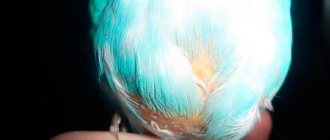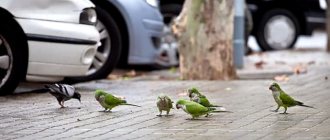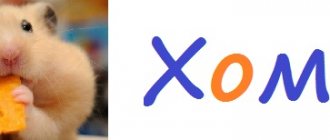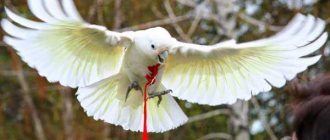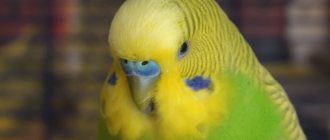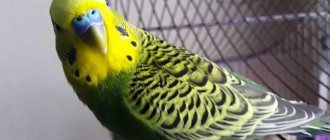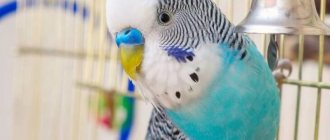The metabolism of birds is accelerated several times compared to humans. Therefore, only a few days may pass from the first symptoms of the disease to a serious condition and even death of the pet. However, as in mammals, the appearance of excrement has important diagnostic significance. It is important to understand what kind of droppings a parrot should have and take timely measures if the texture and color changes.
How much food should a wavy eat per day?
For most pet parrots, a significant portion of their food consists of grain mixtures. On average, one bird eats no more than 2 teaspoons of such food per day. Some breeders immediately pour the entire daily requirement into the pet’s feeder. This saves them time, but can lead to overuse of feed mixtures.
Budgerigars do not have the habit of “filling their tummy” when they are already full. But birds are quite capable of staining all the food with husks or excrement. To avoid the need to replace the entire daily portion of food with a new one, experts advise dividing the daily amount of food for parrots into several parts.
Important! For large breeds of birds, the daily feed requirement is approximately 35–40 g.
If the parrot is healthy, he will not only eat the usual amount of food, but will also not refuse his favorite treat. It is important that there is always drinking water in the bird’s home. This helps the wavy fish regulate the rate of digestion. The drinking bowl is washed and the water in it is renewed daily.
Interesting! Vegetable and fruit nutrition for budgies, as a rule, is not limited. Such products are offered to birds in the form of small pieces that are cleared of seeds and outer skin.
Poisoning of the body
Poisoning of parrots, as a rule, occurs when consuming low-quality grains, water, vegetables and fruits containing nitrates. Poisoning from poisonous indoor plants and medications. Due to inhalation of chemical aerosol substances.
- nausea, vomiting;
- the appearance of seizures;
- lack of coordination;
- the appearance of green or yellow liquid droppings;
- rapid breathing;
- rapid heartbeat;
- a sharp decrease in appetite or complete refusal of food;
- weight loss.
Severe intoxication can cause paralysis. Adsorbent preparations are used to combat poisoning. Medicines are administered in liquid form using a pipette or insulin syringe. The dosage and course of treatment are individual for each type.
There is no such thing as weight loss without a reason. For birds kept in captivity, the presence of such a symptom indicates an inattentive, and in some cases, disdainful attitude towards the bird. A balanced diet and timely recognition of the disease will guarantee the health and longevity of the parrot.
The lifespan of budgerigars at home depends on many nuances. In this publication we will take a closer look at each point.
Possible reasons for refusing to eat
As you know, a healthy parrot always has a good appetite. The parrot will not take extra food from the feeder. If a bird does not eat, much less drink, then there are serious reasons for this. In most cases, they become illnesses or stress. But it also happens that the decisive factor in a parrot’s forced starvation is cold.
Tropical birds are thermophilic enough to not react to a drop in room temperature.
Stress
If your pet has recently arrived at your home, refusing to eat for several days is a normal reaction to an unusual environment. A change of place of residence is always a serious shock for a bird. As soon as the parrot gets used to the environment and new people, it will stop ignoring food.
All that is required from the bird owner is patience, as well as the creation of a calm environment in the room where the parrot’s cage is located. You cannot force your attention on your pet. After a while, the wavy will take the initiative and begin to happily chirp and communicate with the person.
The nervous system of parrots is quite fragile. When habitual circumstances change, combined with natural timidity, birds are able to react with stress not only to a change of place of residence. It often happens that parrots begin to noticeably worry when changing the drinking bowl, changing the composition of the food, or moving the cage to another place.
Interesting! If you cover 2 walls of the parrot’s home with a dark cloth for the first few days, the bird will calm down faster and feel more protected.
Digestive system diseases
According to statistics, gastrointestinal disorders in budgies occur quite often. If the cause of such ailments is emotional overload, then the troubles go away on their own. It is enough to wait 1–2 days. All this time the parrot may not drink or eat.
If a bird’s gastrointestinal disorder occurs due to low-quality feed, the malaise will last longer.
Signs of a serious digestive problem in wavyfish include:
- lack of appetite (or poor appetite);
- liquid droppings;
- lethargy;
- low motor activity of the parrot.
Experienced breeders in this case immediately turn to a veterinarian for help. Many are trying to relieve the symptoms of alleged poisoning with Smecta or Enterosgel, which are added to the water. With this treatment option, the bird is fed dairy-free baby porridge that does not contain salt.
For the health of a budgie, the fruit and vegetable component of nutrition is very important. Each bird has its own food preferences. A parrot may stop eating a particular fruit just because the treat has been offered for several days in a row. In this case, you should choose an alternative option for your pet. Most Wavys love apples, apricots, pears, bananas and cherries.
Other reasons
Budgerigars take their feeding process extremely seriously. They will never eat everything that is given to them, but will choose those foods that are familiar and do not cause concern. If your bird recently arrived at your home from a store or breeder, it most likely did not receive fruits and vegetables for dessert.
It would not be surprising if at first such a parrot refuses to do this. He's just not used to it.
Unusual products
To accustom your parrot to new foods, you need to wait patiently until the pet tries small pieces of the treat. Experts recommend:
- mix a new product with familiar food;
- steam dried fruits before including them in the diet;
- set an example for your pet and personally try the treat in front of the cage.
Vegetable products can be given to the parrot raw or boiled. It is better to cut them or grate them. All root vegetables must be fresh and without signs of rot.
The parrot masters each new product within 2–2.5 weeks. You cannot immediately offer your pet several new treats. It is important to observe your parrot and note how its digestive system reacts to a particular treat. If the bird's droppings become liquid and the wavy itself becomes sad, the product should be immediately excluded from the diet.
Can't find food
This often happens after changing a pet’s cage, or during the period of adaptation of the bird to a new territory. The parrot simply does not notice the feeder, so it does not eat.
In such a situation, you can install several containers with food for your pet and place them on the tray of the cage. This way the bird will immediately find food and will not remain hungry. Over time, the extra feeders are removed and only one is left - the one that the parrot liked the most.
Cold
Do not forget that the most comfortable temperature for pet parrots is considered to be between 22 and 25 degrees Celsius. Signs that your winged pet is freezing are:
- restriction of physical activity;
- lack of appetite;
- slight trembling;
- refusal to fly out of the cage for a walk.
A budgie that experiences discomfort from a drop in room temperature always sits ruffled and shows no desire to communicate. For emergency heating, the birds use a regular incandescent lamp.
It is placed near the cage, turned on and the pet’s condition is monitored. As soon as the bird becomes active and begins to move and chirp, the heating is turned off. You should not let your parrot overheat (when he breathes heavily with his open mouth).
Important! If the pet has a “questionable” concussion or has recently had an injury, do not use a lamp to heat the parrot. In such a situation, it is better to slightly increase the power of the heating devices.
Why are there undigested grains in the droppings?
Undigested grains in a parrot's droppings can occur for a variety of reasons, from harmless to serious. The simplest option: overeating, food is excreted unchanged because the body did not have time to cope with the food. However, this sign is also undesirable, because excess food overloads the bird’s gastrointestinal tract and is dangerous by clogging the crop. Other reasons include:
- dysbacteriosis;
- lack of pancreatic enzymes;
- poor liver function.
An enlarged neck indicates inflammation and blockage of the goiter. This is a serious disease that requires surgery. The veterinary drug Vetom 1.1 helps well against dysbacteriosis.
How long can a parrot live without food?
It has been noticed that the smaller the parrot, the faster it weakens without normal nutrition. The most important factors for the survival of a bird are: the age of the pet and its physical condition.
On average, budgies can live for about 3-4 days without food. If a pet's feathers begin to fall out, this indicates the beginning of irreversible processes in its body that lead to death. Such a parrot requires specialist treatment immediately.
If the bird is too weak, you can maintain its strength with baby food diluted with water. A syringe without a needle is filled with warm liquid gruel and food is injected into the parrot's beak. This is how you need to feed the bird until signs of improvement from drug treatment appear.
Important! If a parrot eats little or does not eat for more than 2 days, there is a real threat to its life.
Damage by ticks
Parasitic infestation of birds can be caused by mites that inhabit the upper layers of the epidermis and internal organs:
- scabies mite (knemidocoptic mange);
- tracheal mite (srentostomosis).
Pronounced knemidocoptosis is characterized by the presence of growths on the paws and beak. When the disease is advanced, the geometry of the beak becomes deformed and changes. The bird develops pain symptoms.
The process of eating is disrupted, which leads to a breakdown in metabolism. The parrot is losing weight. The immune system is weakened. Delay in treatment can lead to the death of your pet.
When infected with a tracheal mite, symptoms of breathing problems, frequent sneezing, throwing back the head, and regurgitation of food appear. The affected mucous membrane of the trachea excludes the possibility of quality nutrition. The passage of food becomes difficult.
Description of appearance
The lovebird has small sizes from 10 to 17 cm. Some individuals reach 20 cm. Body weight ranges from 40 to 60 g. The tail is short in length and reaches 6 cm. The wing length is 4 - 5 cm. Life expectancy is 15 - 20 years. Stocky appearance due to abundant plumage and large head size. The legs are short, very strong, allowing them to overcome obstacles and climb tree branches.
The lovebird's strong beak is its distinguishing feature. Depending on the type, it has a deep red or light yellow color. Natives of the southern - eastern, southern - western parts of Africa are distinguished by their compacted plumage, which is green in color. There are different shades in the chest, neck, and head areas.
Widely known:
- Rosy-cheeked. Most of the plumage is green. Neck, area under the eyes – peach. Individual parts of the tail feathers are blue. The beak is light yellow. Rose-cheeked lovebirds are also found in spotted cream and light blue shades.
- Blackwing. The beak is colored red. The large plumage area is grassy green. The tail is yellow with a black stripe. The species gets its name from its black wings.
- Grey-headed. The inhabitants of palm groves are gray in color with a pearly tint in the area of the head, neck and chest. The beak and paws are gray. The wings and part of the back are rich green. The abdomen and tail are yellow-green in color.
- Collared. The name of this species comes from the peculiarity of the color of the parrot's neck, which resembles an orange “collar”. The beak is black or gray-black in color. Most of the plumage, including the wings, is green. The base of the tail is light blue.
- Red-faced or orange-headed. This species has a bright orange color on the front of the head. The beak is red. Brown eyes with a white circle around them. Most of the plumage is green. The wings are black at the bottom, with a blue tint on top.
Why is diarrhea dangerous in parrots?
Long-term and persistent diarrhea in birds is a dangerous process that can lead to irreparable consequences.
Ornithologists name the following dangers that warn a bird facing this type of indigestion:
- Dehydration.
- Exhaustion.
- Weakness.
- Lethargy.
- Problems with the circulatory system and blood.
- Stretching of the cloaca muscles and discomfort due to this phenomenon.
- Bleeding.
- Death.
Possible complications
What are the complications if loose stools do not go away for a long time?
With prolonged disruption of the functioning of the stomach, nutrients and microelements are practically not absorbed, the bird becomes weak and exhausted, dehydration and intoxication occur.
In the absence of timely treatment for the bird, everything can end in death.
Diarrhea also provokes complications in the form of problems in the functioning of many organs of the parrot, stretching of the muscles of the excretory tract.
Change in litter color
For the most part, the color of the stool depends on what food the parrot ate on the eve of its last bowel movement. The normal state of droppings is considered to be dense and fairly hard, worm-like feces of a brown-green color.
Ornithologists who record the appearance of a bird's stomach disorder first of all pay attention to the change in color in the aftermath of defecation. Based on this or that shade, the doctor can make a specific diagnosis, in some cases
Choosing a drinker
A drinking bowl is a must-have accessory in a wavy cage. It can be internal or external, and open or closed.
It is made of metal or plastic. The choice depends on the preferences of the breeder and the pet itself.
It is advisable to buy an expensive model that is closed on top with some kind of lid, which prevents water contamination.
Do not use cups made of copper, zinc or brass, as they oxidize when exposed to liquid.
Water quality
The water in a parrot's cage should always be clear, fresh and at a temperature of at least 15 degrees; if you give it colder, the bird may catch a cold. It is also not recommended to give the bird too warm water, as it does not quench thirst well.
In the summer, it is better to change it in the drinking bowl every day and not let it heat up. Avoid direct sunlight on water containers, otherwise they will become an excellent breeding ground for microorganisms.
What kind of water should you give your budgie? The best solution is bottled water for children.
There are several reasons why it is better suited:
- Does not contain gas.
- Has the highest degree of purification.
- Contains useful minerals.
But even when buying baby water, carefully read the composition; it is possible that it was not obtained from a well, but is ordinary tap water that has been purified. There is no point in buying such water, you will only need to purchase a filter and purify it yourself, the quality will be the same, and the savings will be significant.
However, you should not take it in large bottles, since when opened it quickly loses its beneficial properties. Under no circumstances should you give your budgie water from the tap or that has been boiled. The first contains rust, chlorine and other harmful substances.
And the second one lost all the elements needed by the body after boiling, but retained chlorine, because it is not destroyed by boiling. Of course, you can let the water sit for some time, but it is better if your bird drinks bottled baby water or filtered water.
Other common ailments
- Obesity often results from excessive care. The lovebird turns from a tightly built, robust bird into a fat, clumsy bird, short of breath and too heavy to lift. An overfed parrot is completely uninterested in mating games.
- Dirty water and poor food cause coccidiosis. Signs: liquid droppings with a pungent odor, rapid weight loss, insatiable thirst. The food comes out undigested.
- When infected with roundworms, the bird’s body becomes intoxicated, it loses weight, becomes lethargic, and its plumage becomes dull. Tests reveal anemia.
- Aspergillosis is a fungal infection. The pathogen is found in moldy food. The lovebird coughs violently and produces blood when coughing. High temperature. If treatment is not started, kidney failure will develop.
- Another type of parasite is fluff eaters. They eat feathers and skin scales. The presence of bugs is indicated by the restless behavior of parrots. They constantly scratch themselves, ruffle their feathers, and rapid molting may begin.
https://www.youtube.com/watch?v=7B0YWjDhPK4
Diseases dangerous to others
Psittacosis
Street birds or parrots that have not undergone quarantine can be carriers of psittacosis, a viral disease. Infection occurs through dust, droppings, and nasal discharge. The disease can also manifest itself in humans.
Ornithosis has the following symptoms:
- drowsiness;
- inactivity;
- shiver;
- inflammation of the eyelids;
- pus from the eyes and nostrils;
- bloody diarrhea;
- unkempt appearance.
The lovebird may refuse to eat and drink a lot of water. Body temperature rises.
The disease develops rapidly. At the first suspicion, you need to show the lovebird to a veterinarian and get tested. Timely treatment with a course of antibiotics, immune and parenteral drugs can save the parrot's life.
Curing an advanced form of the disease is problematic. The parrot may die. All birds that were near the source of infection also need to receive a course of antibiotics.
A bird that has recovered from the disease develops immunity, but continues to be a carrier of the virus for a long time. When contacting potentially infected birds, you need to wear protective clothing, gloves and a mask. After each interaction with the parrot, clothes are disinfected.
When infected, a person may exhibit symptoms of psittacosis and signs of severe flu. In this case, the patient is sent for treatment to the infectious diseases department.
Salmonellosis
The intestinal bacterium Salmonella is the source of salmonellosis infection. A lovebird can become infected from contact with mice, rats, a sick parrot, through food, drink, and droppings. The salmonella bacterium can also be found in shrimp, fish, meat and bone meal, or in raw egg shells. People are also at risk.
Three to four days after infection, the lovebird begins to have bloody diarrhea, the temperature increases, conjunctivitis appears, and the paws and beak may turn blue. The bird becomes drowsy and inactive. Without treatment, the bird's mucous membranes begin to turn yellow, and the legs and wings may fail. Over time, the bird dies.
When the first symptoms of the disease appear, you must immediately have the droppings of the sick bird tested at the nearest veterinary hospital. If the diagnosis is confirmed, the veterinarian will prescribe treatment. In addition, it is necessary to establish the conditions for keeping the parrot and properly balance its diet. All food must be fresh and of high quality.
Knemidocoptosis
Knemidocoptic mange is caused by scabies mites, which choose to live in the horny layers of parrots: beak, wax, paws. They get there from sick birds, through dirty branches or objects brought from the street. Four months after infection, the lovebird develops growths and bald patches on its body. The bird is constantly itching and pulling out feathers. Without treatment, her joints may become inflamed and her paws may fail. As a result, the lovebird dies.
To help the parrot, the cage and bird accessories are disinfected with Disinsectal, rinsed well with clean water and dried. The affected areas of the lovebird's body are treated with aversectin ointment every three days until the bird fully recovers.
Down-eaters
Down-eater mites settle on the body of a lovebird, eat its feathers and particles of stratum corneum, and drink blood. These mites get to the parrot in the same way as scabies. Under their influence, the bird becomes nervous, constantly itches, eats and sleeps poorly. Her feathers become damaged and begin to stick out in all directions.
Treatment begins with treating the cage and equipment with boiling water or Disinsectal. The solution must be thoroughly rinsed off and the items dried. The infected lovebird is treated with Frontline according to the attached instructions and bathed in chamomile infusion.
If you have encountered bird diseases, please share in the comments how to treat them.
If you liked the article, please like it and share it with your friends.

